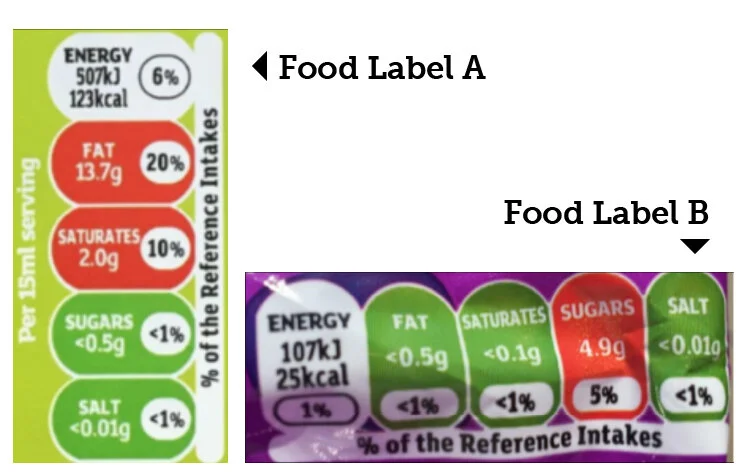What are Food Labels and why is it important to understand them?
“Many people want to engage in behaviours that promote good health, including healthy eating, however most people find it difficult to implement and maintain them”
(Ogden 2007).
Due to the vast array of food and drink that we can freely purchase and consume in our daily environment, many people find healthy eating a challenge. This has led to an obesity crisis in the UK and throughout the World; in fact 2.8 million people are estimated to die annually as a result of obesity (WHO Obesity Fact Sheet). The introduction of nutritional labelling is one example of an intervention which uses text and colours to convey specific information about products and their nutritional information.
“Nutritional labelling has been proposed as an intervention that enables individuals to make healthier choices about the foods they purchase and consume (Cowburn 2005; Dobbs 2014; WHO 2004).”
In 2016 it was made mandatory that all packaged food must display a nutrition declaration for the product. It is therefore compulsory to display the following information on all packaged food and drink:
The amount of energy the food contains. This is shown as both Calories and kilojoules;
The quantity of fat, saturated fat, carbohydrates, sugars, protein and salt. These are shown in grams and are usually shown per 100g for food and per 100ml for liquids.
You may also see the calorie and macronutrient breakdown shown per serving.
It is important to note that the FDA (US Food and Drug Administration) allows inaccuracies of up to 20% on food labelling and the UK GOV allows a 15% variation! For example, any food displaying a 100 kcal label could contain anywhere from 80-120 calories. Similarly, any food displaying a 500 kcal label can contain between 400 and 600 calories!
Daily Recommended Intakes
Food labels usually show the Daily Recommended Intakes. These are:
The average man needs around 2,500kcal (10,500kJ) a day to maintain his weight
The average woman needs around 2,000kcal (8,400kJ)
“The FDA settled on 2,000 Calories, concluding that the public health risks of overconsumption outweighed the extremely low risk that individuals with greater calorie needs would consume inadequate amounts of fat, carbohydrates and other nutrients.” Harvard Health Policy Review, 2003.
Included on food labels are the Reference Intake (RI). The RI is a guide for the approximate daily amount of nutrients (fats, saturated fats, salt and sugar) and energy required for a healthy diet. This is shown as a percentage (%) on the food label.
Similar to the RDI, the RI values are based on the women’s intake of 2000 Calories per day. It is also based upon an individual undertaking an average amount of physical activity (i.e. not sedentary).
As part of a healthy balanced diet, an adult's RI for a day are:
Energy: 2,000kcal (8,400 kJ)
Total fat: 70g
Saturates: 20g
Carbohydrate: 260g
Total sugars: 90g
Protein: 50g
Salt: 6g
The protein levels in this RI recommendation are very low and actually come from the Reference Nutrient Intake (RNI), which recommends the consumption of 0.8g/kg of body weight, which is the minimum amount to avoid deficiency. However, for optimal health studies show this value is too low. Current evidence indicates intakes in the range of at least 1.2 to 1.6 g/kg of high-quality protein is a more ideal target for achieving optimal health (Philips et al. (2016). Older adults should also consume even more than the previous recommended amount: around 0.4- 0.6g/kg at each meal. As we age we become resistant to the amino acids in protein, therefore older adults require higher quantities of protein to stimulate equivalent Muscle Protein Synthesis and grow muscle proteins.
Typical Nutrition Labels
The UK government has a traffic light system in place to allow consumers to quickly identify which foods are healthier than others. Here is an example of a typical label showing the traffic light system:
The nutritional information is colour coded to make it easy to identify at a glance if the food has high, medium or low amounts of fat, saturated fat, sugars and salt:
RED means the food contains a high level
AMBER means the food contain a medium level
GREEN means the food contains a low level
If the label has more GREEN boxes it shows the food is a healthier choice. These types of foods can be consumed regularly.
If the label has AMBER boxes it is neither high nor low, so you can eat foods regularly,
If there are RED boxes on the label means the food is high in fat, saturated fat, salt or sugars, and these are the foods we should cut down on. These foods should be consumed less often.
BE AWARE!!
This sounds great in theory, however in practice this traffic light system can be misleading. For example:
Label A looks like an unhealthy choice; however, it is the label from Extra Virgin Olive Oil. When consumed as part of a balanced diet, Extra Virgin Olive Oil is a really good source of fat to cook with and for dressing salads. It is a monounsaturated oil rich in Omega 9 and Oleic Acid, and which is known to actually improve blood lipids.
Similarly, Label B looks like a healthy choice using the traffic light system as it has 3 green boxes, however it is actually the front of a packet of sweets and is the nutritional information for 1 sweet. How easy would it be to eat a handful of these and consume 200 Calories in the space of a few minutes?
As you can see from the labels, protein is not included in the traffic light system. It is known to be a vital part of our diet as it is involved in most biological processes and we need to consume it to function. It is essential for the body to use for structural functions, transport, enzyme function, immune function, production of hormones, maintaining fluid balance and energy balance. As well as health benefits such as healthy hair & skin, increased protein intake can support weight-loss, increase satiety, muscle retention and is essential for immune function.
Allergens and Intolerances
All packaging must also show any allergens which may be in the product within the ingredients list on the label.
On packaging you will find these allergens shown in the following ways:
Use bold, underline or italics
Change the colour of the text
There are 14 specified substances or products causing allergies or intolerances which must be highlighted:
Cereals containing gluten
Crustaceans - including prawns, crabs, lobster and crayfish
Peanuts
Eggs
Fish
Nuts - including brazil nuts, pistachios, almonds, hazelnuts, walnuts, pecans, cashews and macadamia nuts
Soybeans
Milk
Celery and celeriac
Mustard
Sesame
Lupin
Molluscs - including clams, mussels, whelks, oysters and squid
Sulphur dioxide / sulphites (a preservative found in some dried fruit) - but only when present in concentrations over 10 mg/kg or 10 mg/l
Previously allergens were stated on packaging using short statements like "Contains nuts" or "Contains shellfish" however the regulations have now changed and this type of information isn’t allowed on the packaging unless the product is not required to display an ingredient list.
Most pre-packed food products also have a list of ingredients on the packaging or an attached label. As well as informing you of the breakdown of ingredients, it can help you to work out how healthy the product is. Ingredients are listed in order of weight, therefore the main ingredients in the packaged food are always listed first.
How useful is the information provided to us on packaging?
We all have different energy requirements, which vary depending upon weight, height, lifestyle, unplanned activity (NEAT), the thermic effect of food (the energy required to digest food) and overall energy expenditure. The FDA base their food labels and recommendations upon the average level of physical activity, therefore they are not inaccurate recommendations for those who are inactive (the majority of the population) as well as those who might need a higher calorie intake to fuel a more active lifestyle. Whilst some food labelling has made it easier to identify and differentiate between healthy foods and unhealthy foods, there are also many marketing strategies from big brands which encourage the purchase of unhealthy foods, especially in disadvantaged low and middle income communities where further education around healthy eating and the labelling system is required. Overall, further evaluations of the effectiveness of nutritional labelling and other interventions to promote healthier food purchasing and consumption is warranted.
VICKY ENGLAND | ARISTOS NUTRITIONIST
If you would like any help with nutrition then check out our Personal Nutrition Service. We can provide an individualised nutrition package based on your lifestyle and goals.


